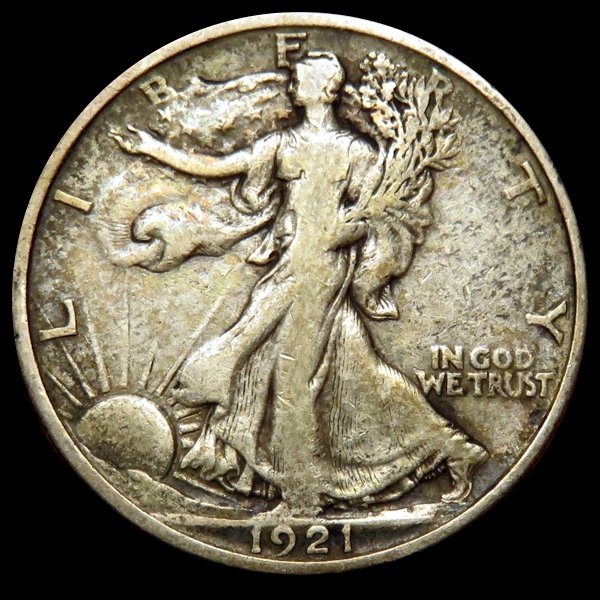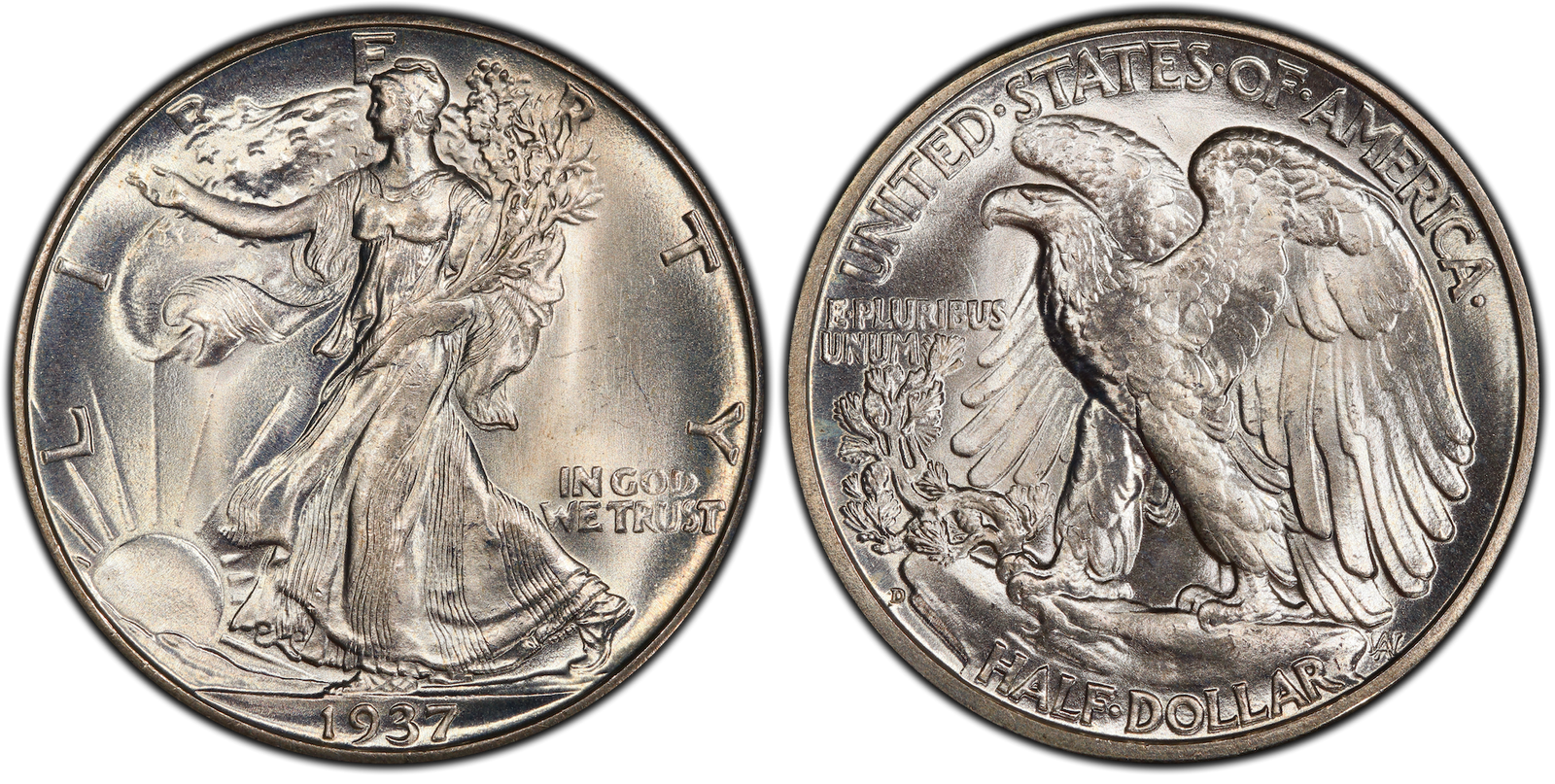
The Walking Liberty half dollar was the largest denomination that regularly circulated during the first half of the twentieth century.
One might occasionally have encountered silver dollars, and before Franklin Roosevelt's proclamation restricting private gold usage in 1934, a consumer may have rarely seen circulating gold.
Unlike today, where half dollars are exceedingly rare in pocket change, many transactions would have included a Walking Liberty half, especially in the series' earlier years prior to the Great Depression.
Walkers, as they have come to be known, were also considered some of the most artistically appealing coins in the world.
The obverse, in particular, combines striking beauty and thoughtful symbolism.
Walking Liberty halves outlived Mercury dimes and Standing Liberty quarters, but were substituted for Franklin halves in 1948.
As with other "ninety percent" circulating silver coinage, Walking Liberty halves contain ninety percent silver and ten percent copper.
They weigh 12.5 grams and hold .36169 troy ounces of silver.
At 30.63mm, they are well over one inch in diameter.
The 1921-D is considered the key date in the series, but one finds a degree of parity when evaluating which Walking Liberty halves are scarce.
Save for a few common P-mints, all dates hitherto the Great Depression are at least moderately rare, and this entire lot of early specimens is very rare in high grades.
Some semi-key dates include 1921-P, 1921-S, 1920-D, 1918-D, and 1916-S.
Perhaps a dozen more could stake claim to being among this group.
This series is one of the few without any significant varieties to speak of.
The 1946 doubled die reverse may be the most popular, but it has not caught on as a "must-have" for most collectors.
To employ a pun, collecting Walkers is a story of two halves.
All the dates minted after the Great Depression are common, and (nearly) all those minted before are in short supply.
Putting together a completed set in a grade of "fine" or higher is reserved for advanced collectors because the semi-keys are all condition rarities.
Unfortunately, well-worn coins hardly approach the attraction this coin has to offer.
Collectors are thus left with the tough choice between sacrificing quality or extending their coin budget.
Some dates show softly struck details at the high points, but this is only mildly distracting.
The vast majority of coins are sufficient to capture the essence of the design.
Inauthentic coins do come to the market occasionally.
Most of these are crude copies or legitimate mint products with an added mintmark.
A number of low-grade 1921-S coins with a removed mintmark (to appear as a 1921-P) exist as well.
All attempts to produce high-grade fakes have been easy to spot.
Primary Obverse Devices:
The obverse of the Walking Liberty half dollar portrays the personification of Liberty walking with a determined gait.
Her right arm is outstretched, and she bears a resolute countenance across her face as if to calmly beckon to American citizens.
A waving flag of the United States appears to make up the upper portions of her flowing dress.
She wears sandals on her feet and a Phrygian Cap on her head.
The latter is a symbol synonymous with the concept of liberty, having been used in both the American and French Revolutions.
Date, Mintmark, and Designer Initials:
The date appears at the six o'clock position on the obverse.
Walking Liberty Halves were minted from 1916 through 1947, with exceptions in the years 1922, 1924-26, and 1930-32.
For coins struck during 1916 and a portion of 1917, the mintmark can be found on the obverse beneath the motto "In God We Trust."
For the remainder of the series, the mintmark is located on the reverse close to the rim, halfway between the six o'clock and nine o'clock positions.
Coins minted in Philadelphia do not bear a mintmark, and those minted in Denver or San Francisco show "D" or "S" mintmarks, respectively.
Not all mints produced coins in the same year at various points during the series.
Adolph Weinman designed the Walking Libery half, and his monogram "AW" appears on the reverse close to the rim by the five o'clock position.
Primary Reverse Devices:
A particularly imposing eagle is featured on the reverse of the Walking Liberty half dollar.
The feather detail shows especially deep contours, and the eagle's talons are prominent.
Mottoes:
Though three of its letters are slightly obscured, the motto "Liberty" is featured along the rim of the obverse.
Liberty implies the spirit of freedom, especially freedom from political oppression, and has been an American theme since the country's founding.
Perhaps looking a bit out of place, the motto "E. Pluribus Unum" is located in front of the eagle device on the coin's reverse.
It literally translates to "out of many, one" and represents the coming together of the original thirteen colonies into a single country during the nation's founding.
"In God We Trust" is written on the coin's obverse behind Liberty's back leg.
This motto became popular in the United States during the Civil War.
There is some debate over whether the phrase has a purely religious meaning or if cultural and political implications are assumed as well.
Other Secondary Devices:
The coin's reverse includes a rock formation on which the eagle sets down.
Out of this rock formation grows a type of coniferous vegetation.
The design likely implies a high mountain location near the tree line.
As Liberty steps forward she approaches a beaming sun over a mountain.
This is surely a sunrise, as opposed to a sunset, given that long rays of sunlight are typically associated with a rising sun, and the symbolism of a sunrise would be more appropriate.
Liberty is carrying with her branches of laurel and oak, which have represented strength and triumph since antiquity.
The coin's date also sits on a platform at the base of the design.
Country and Denomination:
The coin's country of origin and denomination are found on the reverse.
"United States of America" is written in the coin's field toward the top.
"Half Dollar" is written on the rocky crag at the base of the design.

